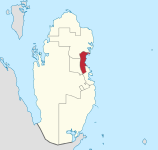Al Daayen
| Al Daayen الضعاين | |
|---|---|
| Municipality | |
 Map of Qatar with Al-Daayen highlighted | |
| Coordinates (Al-Daayen): 25°35′N 51°28′E / 25.583°N 51.467°ECoordinates: 25°35′N 51°28′E / 25.583°N 51.467°E | |
| Country |
|
| Capital | Al-Daayen |
| Population (2010)[1] | |
| • Total | 43,176 |
| Time zone | AST (UTC+3) |
| ISO 3166 code | QA-RA |
Al Daayen (Arabic: الضعاين) is a municipality in the state of Qatar, the seventh in the Ministry of Municipality and Urban Planning, after the municipalities of Doha, Al-Rayyan, Al-Wakrah, Umm Salal, Al-Khor and Dhekra, and Al-Shamal. Municipalities' history in Qatar dates back to 1963 when the Municipality of Qatar was created as the first municipality by virtue of law No. 11. The Municipality of Qatar was considered the mother of all other municipalities till it became the Municipality of Doha and had a legal personality as a public institution, which aim is to work using best means so as to develop the country in the urban and health domains.
With the demographic and urban growth of the country over the last years, there was the need to create Al-Daayen Municipality. The Emir of Qatar ratified the government's resolution No.13 in 2004 on the creation of the municipality, which have a legal personality and follows the Ministry of Municipality and Urban Planning.
Most important cities and villages
Al-Daayen Municipality serves a big number of cities and villages within its administrative limits, among which are: Al-Abib, al-Ab, Jeryan Jenayhat, al-Khaysa, Rawdat al-Hamama, Wadi al-Wasaa, al-Sakhama, al-Masrouhiya, Wadi Lucil, Umm Qarn, al-Daayen, Smaismah, al-Jeryan, Tanbak, Rahiya, al-Ghaf, Ras al-Nuf. The Municipalities coordinates with the urban planning for the rest of new cities and villages.
Developments
In the last few years, Al Daayen had developed in a number of areas.
Most important roads
The most important roads connecting cities and villages of the Municipality are:
- Al-Shamal Road
- Al-Khor New Road
Maintenance works were carried out for al-Khaysa roads north of Umm Salal Mohammad and east of Umm Salal Ali and Umm Qarn, as well as regions under the authority of the Municipality.
Most important projects
- Creating Al-Daayen Municipality Service Center.
- Creating gardens in Umm Qarn.
- Al-Dahil garden has been finished and received.
- Circuits have been garnished.
- Currently working to build a garage and residences for workers in the farm region.
- A garage and residences for workers in the industrial zone of al-Khor and Dhekhra have been created.
Prospect projects
- Building a celebrations hall.
- Building a fence around archeological sites.
- Making new gardens.
- Building a fence around old cemeteries.
Administrative structure
The administrative structure of the Municipality is like that of other municipalities, and is determined according to the structural development policy of the Ministry.
The departments of the Municipality are as follows:
- Administrative Affairs Department
- Financial Affairs Department
- Organization, Construction Licenses, and Municipality Projects Department
- Commercial Licenses and Advertisements Department
- Pests and Rodents Fighting Department
- General Cleanness and Sewage Department
- Food Control Department
- Cemeteries Services Department
- Land Control Department
- Public Gardens Department
- Technical Support Department
The director of the Municipality
After the government's resolution on the creation of Al-Daayen Municipality, His Excellency, Dr. Sultan Ben Hasan al-Dabet al-Dusary, Minister of Municipal Affairs and Agriculture designated Mr. Nasser Abdullah Saeed al-Kaabi to be the director of the Municipality. He was the assistant director for administrative and financial affairs in the Umm Salal Municipality, and before that head of the legal affairs department in the Ministry. On 22/9/2008, the Minister of Municipality and Urban Planning Abdul Rahman Ben khalifa Al-Thani issued ministerial resolution No.34 on the designation of Mr. Fahd Mohammad Fahid al-Qohtani as the director of Al-Daayen Municipality; he previously was assistant director of al-Rayan Municipality for Technical Affairs.
As for the personnel, heads of departments were designated by virtue of ministerial resolution No. 149/2005 AD. These departments are: Commercial Licenses, General Cleanness, Administrative Affairs, Financial Affairs, and Food Control. Were also designated employees at the typing and archives section in the Municipality, salon inspectors, and public gardens controllers.
Municipality headquarters
Municipality headquarters are south east of Sumaysma Bridge, on a 3000 m² area. The building is constituted of administration offices, meetings room, departments' offices and facilities, car parking (30 spots), a mosque, and a public reception room (Grievances and Consultations Department). The headquarters have been equipped with offices, newest personal computers and other appliances, and all work requirements. The following table shows the registered live births by nationality and sex for this municipality.[2][3] Place of births is based on home municipality of mother at birth.
| Year | Qatari Male | Qatari Female | Total Qatari | Non Qatari Male | Non Qatari Female | Total Non Qatar | Total Male | Total Female | Grand Total | |
|---|---|---|---|---|---|---|---|---|---|---|
| 2007 | 2 | 6 | 8 | 2 | 1 | 3 | 4 | 7 | 11 | |
| 2008 | 42 | 40 | 82 | 4 | 11 | 15 | 46 | 51 | 97 | |
| 2009 | 68 | 58 | 126 | 16 | 15 | 31 | 84 | 73 | 157 |
References
- ↑ "Census 2010". Qatar Statistics Authority. 2010. Archived from the original on 9 July 2010. Retrieved 2010-07-25.
- ↑ http://www.qix.gov.qa
- ↑ "Qatar Statistics Authority website". Qsa.gov.qa. Retrieved 2011-09-09.